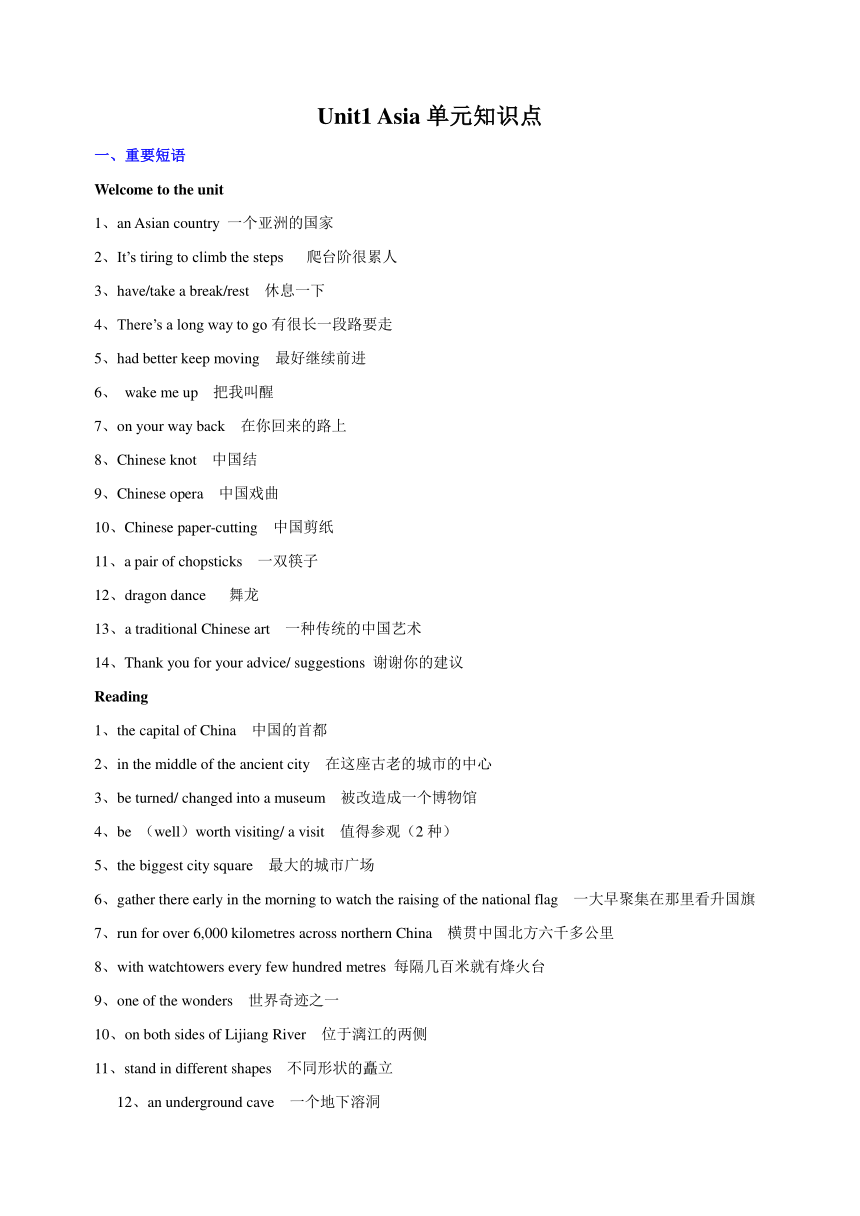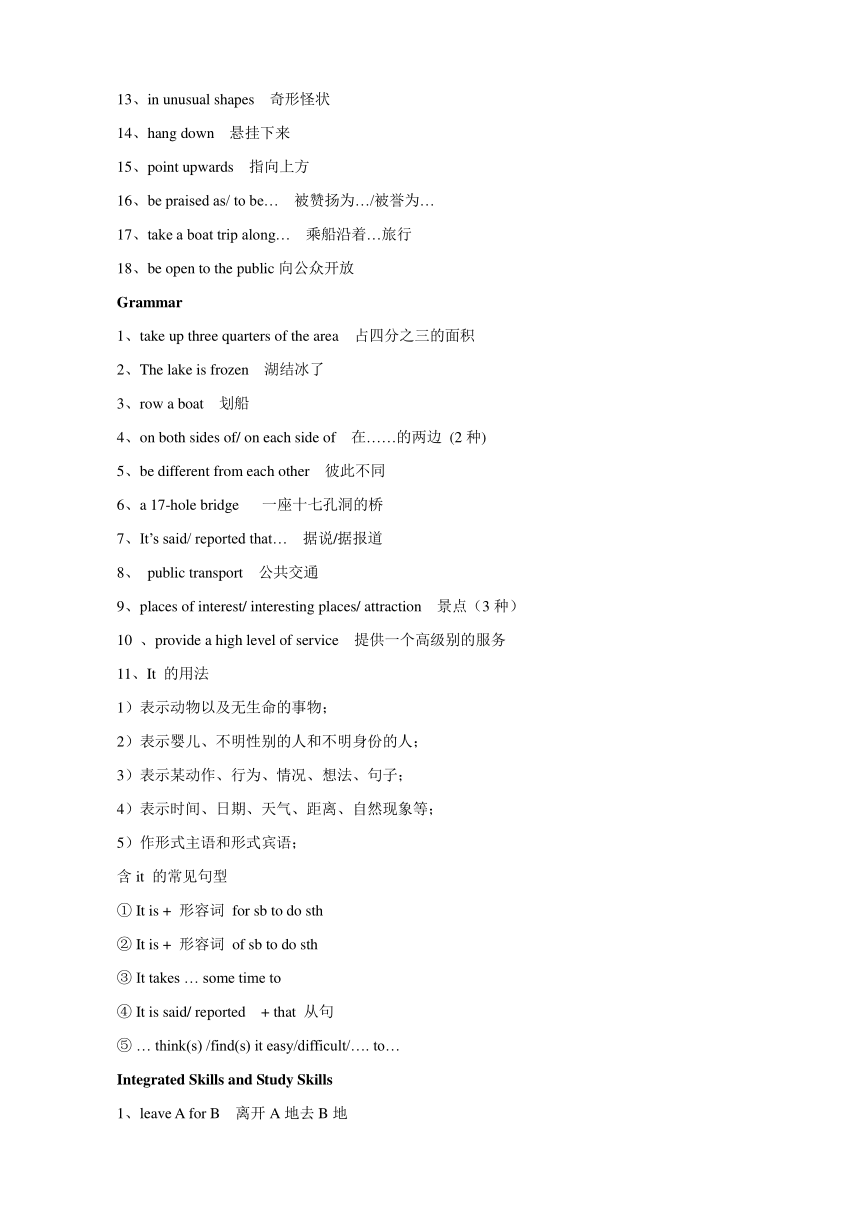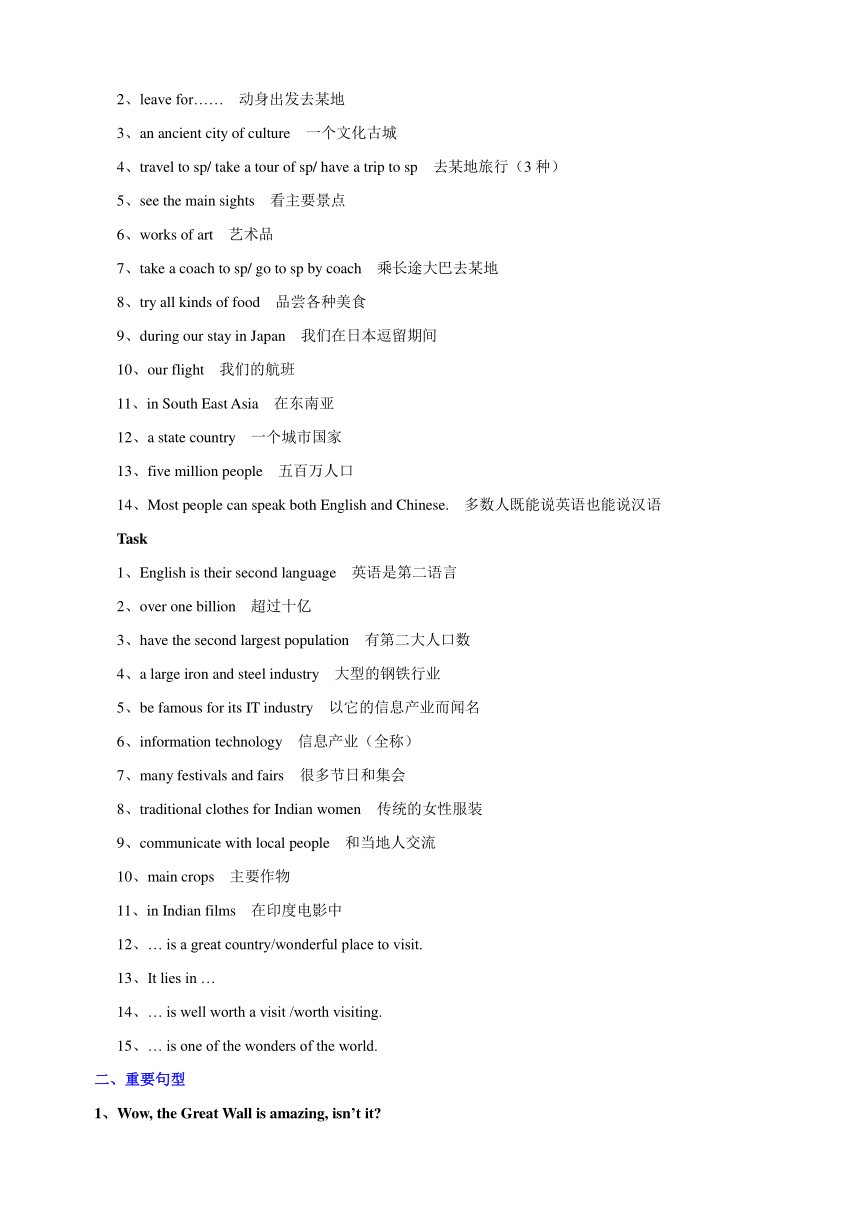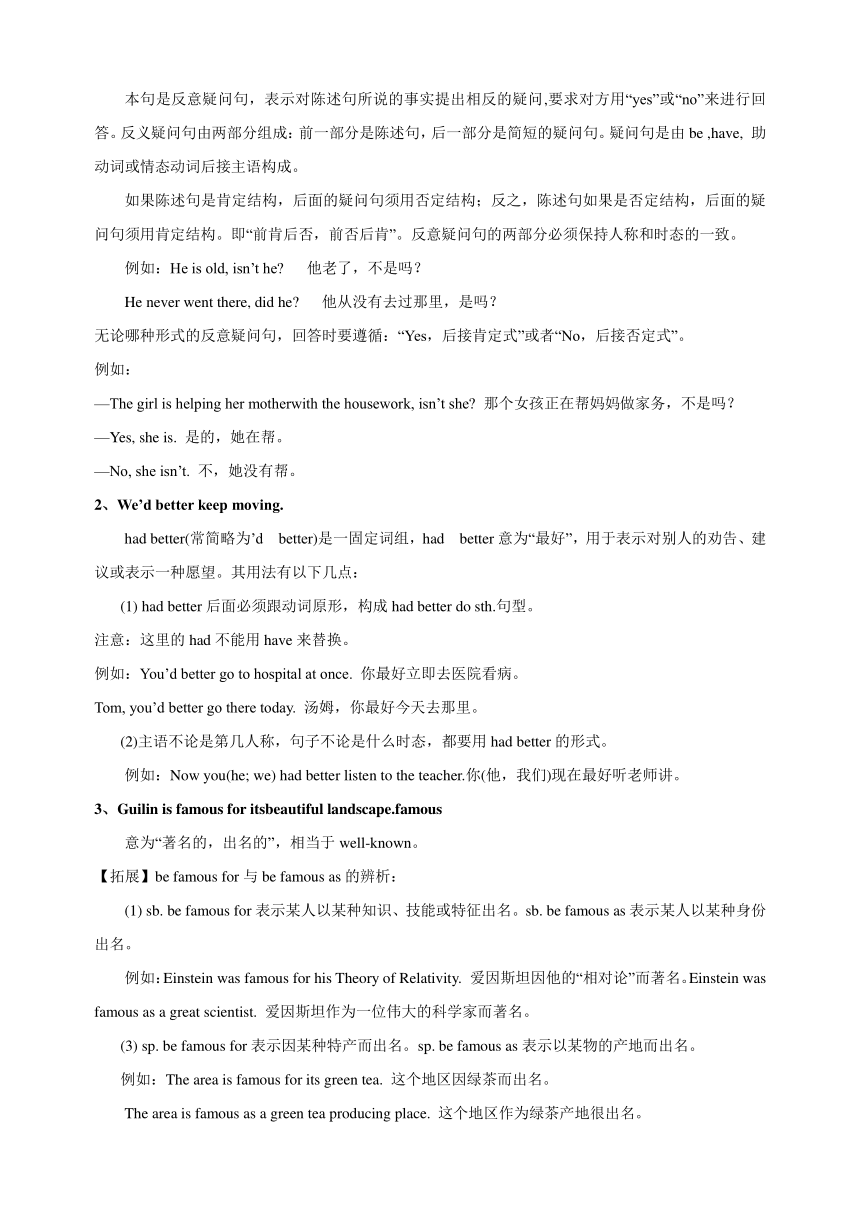译林版九年级下册英语 Unit 1 Asia 单元知识点讲义
文档属性
| 名称 | 译林版九年级下册英语 Unit 1 Asia 单元知识点讲义 |  | |
| 格式 | doc | ||
| 文件大小 | 51.0KB | ||
| 资源类型 | 教案 | ||
| 版本资源 | 牛津译林版 | ||
| 科目 | 英语 | ||
| 更新时间 | 2024-03-19 17:23:28 | ||
图片预览




文档简介
Unit1 Asia单元知识点
一、重要短语
Welcome to the unit
1、an Asian country 一个亚洲的国家
2、It’s tiring to climb the steps 爬台阶很累人
3、have/take a break/rest 休息一下
4、There’s a long way to go有很长一段路要走
5、had better keep moving 最好继续前进
6、 wake me up 把我叫醒
7、on your way back 在你回来的路上
8、Chinese knot 中国结
9、Chinese opera 中国戏曲
10、Chinese paper-cutting 中国剪纸
11、a pair of chopsticks 一双筷子
12、dragon dance 舞龙
13、a traditional Chinese art 一种传统的中国艺术
14、Thank you for your advice/ suggestions 谢谢你的建议
Reading
1、the capital of China 中国的首都
2、in the middle of the ancient city 在这座古老的城市的中心
3、be turned/ changed into a museum 被改造成一个博物馆
4、be (well)worth visiting/ a visit 值得参观(2种)
5、the biggest city square 最大的城市广场
6、gather there early in the morning to watch the raising of the national flag 一大早聚集在那里看升国旗
7、run for over 6,000 kilometres across northern China 横贯中国北方六千多公里
8、with watchtowers every few hundred metres 每隔几百米就有烽火台
9、one of the wonders 世界奇迹之一
10、on both sides of Lijiang River 位于漓江的两侧
11、stand in different shapes 不同形状的矗立
12、an underground cave 一个地下溶洞
13、in unusual shapes 奇形怪状
14、hang down 悬挂下来
15、point upwards 指向上方
16、be praised as/ to be… 被赞扬为…/被誉为…
17、take a boat trip along… 乘船沿着…旅行
18、be open to the public向公众开放
Grammar
1、take up three quarters of the area 占四分之三的面积
2、The lake is frozen 湖结冰了
3、row a boat 划船
4、on both sides of/ on each side of 在……的两边 (2种)
5、be different from each other 彼此不同
6、a 17-hole bridge 一座十七孔洞的桥
7、It’s said/ reported that… 据说/据报道
8、 public transport 公共交通
9、places of interest/ interesting places/ attraction 景点(3种)
10 、provide a high level of service 提供一个高级别的服务
11、It 的用法
1)表示动物以及无生命的事物;
2)表示婴儿、不明性别的人和不明身份的人;
3)表示某动作、行为、情况、想法、句子;
4)表示时间、日期、天气、距离、自然现象等;
5)作形式主语和形式宾语;
含it 的常见句型
① It is + 形容词 for sb to do sth
② It is + 形容词 of sb to do sth
③ It takes … some time to
④ It is said/ reported + that 从句
⑤ … think(s) /find(s) it easy/difficult/…. to…
Integrated Skills and Study Skills
1、leave A for B 离开A地去B地
2、leave for…… 动身出发去某地
3、an ancient city of culture 一个文化古城
4、travel to sp/ take a tour of sp/ have a trip to sp 去某地旅行(3种)
5、see the main sights 看主要景点
6、works of art 艺术品
7、take a coach to sp/ go to sp by coach 乘长途大巴去某地
8、try all kinds of food 品尝各种美食
9、during our stay in Japan 我们在日本逗留期间
10、our flight 我们的航班
11、in South East Asia 在东南亚
12、a state country 一个城市国家
13、five million people 五百万人口
14、Most people can speak both English and Chinese. 多数人既能说英语也能说汉语
Task
1、English is their second language 英语是第二语言
2、over one billion 超过十亿
3、have the second largest population 有第二大人口数
4、a large iron and steel industry 大型的钢铁行业
5、be famous for its IT industry 以它的信息产业而闻名
6、information technology 信息产业(全称)
7、many festivals and fairs 很多节日和集会
8、traditional clothes for Indian women 传统的女性服装
9、communicate with local people 和当地人交流
10、main crops 主要作物
11、in Indian films 在印度电影中
12、… is a great country/wonderful place to visit.
13、It lies in …
14、… is well worth a visit /worth visiting.
15、… is one of the wonders of the world.
二、重要句型
1、Wow, the Great Wall is amazing, isn’t it
本句是反意疑问句,表示对陈述句所说的事实提出相反的疑问,要求对方用“yes”或“no”来进行回答。反义疑问句由两部分组成:前一部分是陈述句,后一部分是简短的疑问句。疑问句是由be ,have, 助动词或情态动词后接主语构成。
如果陈述句是肯定结构,后面的疑问句须用否定结构;反之,陈述句如果是否定结构,后面的疑问句须用肯定结构。即“前肯后否,前否后肯”。反意疑问句的两部分必须保持人称和时态的一致。
例如:He is old, isn’t he 他老了,不是吗?
He never went there, did he 他从没有去过那里,是吗?
无论哪种形式的反意疑问句,回答时要遵循:“Yes,后接肯定式”或者“No,后接否定式”。
例如:
—The girl is helping her motherwith the housework, isn’t she 那个女孩正在帮妈妈做家务,不是吗?
—Yes, she is. 是的,她在帮。
—No, she isn’t. 不,她没有帮。
2、We’d better keep moving.
had better(常简略为’d better)是一固定词组,had better意为“最好”,用于表示对别人的劝告、建议或表示一种愿望。其用法有以下几点:
(1) had better后面必须跟动词原形,构成had better do sth.句型。
注意:这里的had不能用have来替换。
例如:You’d better go to hospital at once. 你最好立即去医院看病。
Tom, you’d better go there today. 汤姆,你最好今天去那里。
(2)主语不论是第几人称,句子不论是什么时态,都要用had better的形式。
例如:Now you(he; we) had better listen to the teacher.你(他,我们)现在最好听老师讲。
3、Guilin is famous for itsbeautiful landscape.famous
意为“著名的,出名的”,相当于well-known。
【拓展】be famous for与be famous as的辨析:
(1) sb. be famous for表示某人以某种知识、技能或特征出名。sb. be famous as表示某人以某种身份出名。
例如:Einstein was famous for his Theory of Relativity. 爱因斯坦因他的“相对论”而著名。Einstein was famous as a great scientist. 爱因斯坦作为一位伟大的科学家而著名。
(3) sp. be famous for表示因某种特产而出名。sp. be famous as表示以某物的产地而出名。
例如:The area is famous for its green tea. 这个地区因绿茶而出名。
The area is famous as a green tea producing place. 这个地区作为绿茶产地很出名。
4、I hope you can visit my city one day!
hope作动词,“希望,盼望,期待”,其后接不定式作宾语,即hope to do 或者跟that从句,that可以省略。但是不能用hope sb. to do的形式。
例如:We hope to see you soon. 我们希望不久就能见到你。
I hope you can pass the exam. 我希望你能通过考试。
【拓展】辨析:hope与wish
(1)相同点:表示“想;希望”,宾语可为to do,不能用doing。
例如:I hope/wish to visit Guilin. 我希望去桂林观光。
(2) 不同点:wish后可以跟复合宾语,即wish sb. to do sth.,而hope不能。
例如:I wish you to go.(正) 我希望你去。I hope you to go.(误) 我希望你去。
(3) 两者都可接that从句,但是“hope + that从句”表示希望,“wish + that从句”表示愿望,且从句的谓语动词要用虚拟语气。
例如:I hope you’ll be better soon. 我希望你很快好起来。
I wish I were really wealthy. 但愿我真的富有。
(4) wish后可接双宾语。例如:We wish you a happy New Year! 我们祝你新年快乐!
5、Many people find it pleasant to travel around.
find it + adj.+ (for sb.) to do sth.
意为“发现做某事(对某人来说)是 ”。其中it作形式宾语,真正的宾语是后面的动词不定式结构,形容词作宾语补足语。这一结构可改成由that引导的宾语从句,在it和形容词之间加适当的be动词即可。
例如:I find it easy for me to finish the work in an hour. I find that it is easy for me to finish the work in an hour. 我发现对我来说在一小时内完成工作很容易。
【拓展】还可以用于这种句式结构的单词有:think,consider,feel等。
例如:I think it important to make good friends. 我认为结交好朋友很重要。
三、语法
it用法完全归纳
一、it 作人称代词的用法
◆1、指事物
作为人称代词,it 可以除人以外的一切事物或动物。如: I dropped my watch and it broke. 我把手表掉在地上摔坏了。
◆2、指人
it 指人主要用于指不性别不明的婴儿或用于确认某人的身份。如: Is it a boy or a girl 是男孩还是女孩
There is a knock on the door. It must be the postman. 有人在敲门,一定是邮递员。
【说明】在答语中,常用来指本人,如说 It’s me。
◆3、代替某些代词
代词 it 还可用于代替指示代词this, that 以及复合不定代词 something, anything, nothing等。
如: “What’s this ” “It’s a new machine. ” “这是什么 ”“是一种新机器”。
Nothing is wrong, is it 没出什么问题,是吗
二、it 作非人称代词的用法
◆1、基本用法
it 作非人称代词的用法,主要用于指时间、距离、价值、天气、气候及温度等自然现象。
如: It’s too late to go there now. 现在去那儿已经太迟了。
It can get very hot here. 这里有时会很热。
◆2、用于某些句型
It’s time for sth. 该做某事了。
It’s time to do sth. 该做某事的时候了。
It’s time for sb to do sth. 某人该干某事了。
It’s (about / high) time + that-从句. 某人该做某事了。(从句谓语用过去式,有时也用“should+动词原形”)
It’s first (second) time + that-从句. 某人第几次干某事。(从句谓语用现在完成时)
It’s + 时间段 + since-从句. 自从……有一段时间了。
It’s + 时间段 + before-从句. 过多长的时间才……
三、it用作形式主语
◆1、基本用法
当不定式、动名词、从句等复杂成分用作句子主语时,为保持句子平衡,通常把真正的主语放在句末,而在句首使用形式主语it。
如: It’s very important to remember this. 记住这一点很重要。
◆2、用作形式主语的的重要句型
◇(1) It + be + adj. for (of) sb to do sth 某人做某事……
It is hard for him to make up his mind. 他很难下定决心。
It was foolish of her to say such a thing. 她说那样的话,真是太蠢了。
【说明】介词 of 与 for 的区别是:of 用于指某人的性格、属性、特征等,介词for表示对象,意为“对……来说”
◇(2) It takes sb + 时间段 + to do sth. 某人做某事花了……时间
It takes years to master a new language. 要花多年的时间才能掌握一门新的语言。
【说明】此句型可以有以下多变种变体:It took me an hour to write the letter. =The letter took me an hour (to write). =I took an hour to write the letter. 我写这封信花了一个小时。
◇(3) It is up to sb to do sth. 该由某人做某事
It’s up to you to to make the choice. 得由你来作选择。
◇(4) it look (seem, appear, happen, occur) that [as if] 似乎……
It seemed as though he didn’t recognize me. 他似乎没认出我来。
◇(5) If it were not for / If it hadn’t been for 若不是因为……
If it were not for their help, we couldn’t have got over the difficulties.
四、it用作形式宾语
◆1、基本用法
当不定式、动名词、从句等复杂成分用作宾语且其后跟有宾语补足语时,通常会在宾语补足语前使用形式宾语,而将真正的宾语移至句末。其基本结构为“动词+it+宾语补足语+不定式(动名词或从句)”。
如: I find it difficult to do the job well. 我发现做好这件事不容易。
◆2、用作形式宾语的几个特殊结构
◇(1) 动词+ it + that-从句。
如: I like it that you came. 你来了,我很高兴。
【说明】能用于此结构的动词不多,常见的有 have, take, put, like 等。
◇(2) 动词 + it + when (if)-从句。
如: I dislike it when you whistle. 我不爱听你吹口哨
【说明】能用于此结构的动词不多,常见的有 enjoy, hate, love, like, dislike, appreciate, prefer 等。
◇(3) 动词 + prep + it + that-从句。
如: See to it that you’re not late again. 注意千万不要再迟到。
【说明】能用于此结构的动词不多,常见的有see to, look to, insist on, stick to, depend on, answer for 等。
◇(4) 动词 + it + 介词短语+ that-从句。
如: I owe it to you that I am still alive. 多亏有你我才仍然活着。
【说明】能用于此结构的动词不多,常见的有take it for granted, bring it to sb’s attention, owe it to sb 等。
一、重要短语
Welcome to the unit
1、an Asian country 一个亚洲的国家
2、It’s tiring to climb the steps 爬台阶很累人
3、have/take a break/rest 休息一下
4、There’s a long way to go有很长一段路要走
5、had better keep moving 最好继续前进
6、 wake me up 把我叫醒
7、on your way back 在你回来的路上
8、Chinese knot 中国结
9、Chinese opera 中国戏曲
10、Chinese paper-cutting 中国剪纸
11、a pair of chopsticks 一双筷子
12、dragon dance 舞龙
13、a traditional Chinese art 一种传统的中国艺术
14、Thank you for your advice/ suggestions 谢谢你的建议
Reading
1、the capital of China 中国的首都
2、in the middle of the ancient city 在这座古老的城市的中心
3、be turned/ changed into a museum 被改造成一个博物馆
4、be (well)worth visiting/ a visit 值得参观(2种)
5、the biggest city square 最大的城市广场
6、gather there early in the morning to watch the raising of the national flag 一大早聚集在那里看升国旗
7、run for over 6,000 kilometres across northern China 横贯中国北方六千多公里
8、with watchtowers every few hundred metres 每隔几百米就有烽火台
9、one of the wonders 世界奇迹之一
10、on both sides of Lijiang River 位于漓江的两侧
11、stand in different shapes 不同形状的矗立
12、an underground cave 一个地下溶洞
13、in unusual shapes 奇形怪状
14、hang down 悬挂下来
15、point upwards 指向上方
16、be praised as/ to be… 被赞扬为…/被誉为…
17、take a boat trip along… 乘船沿着…旅行
18、be open to the public向公众开放
Grammar
1、take up three quarters of the area 占四分之三的面积
2、The lake is frozen 湖结冰了
3、row a boat 划船
4、on both sides of/ on each side of 在……的两边 (2种)
5、be different from each other 彼此不同
6、a 17-hole bridge 一座十七孔洞的桥
7、It’s said/ reported that… 据说/据报道
8、 public transport 公共交通
9、places of interest/ interesting places/ attraction 景点(3种)
10 、provide a high level of service 提供一个高级别的服务
11、It 的用法
1)表示动物以及无生命的事物;
2)表示婴儿、不明性别的人和不明身份的人;
3)表示某动作、行为、情况、想法、句子;
4)表示时间、日期、天气、距离、自然现象等;
5)作形式主语和形式宾语;
含it 的常见句型
① It is + 形容词 for sb to do sth
② It is + 形容词 of sb to do sth
③ It takes … some time to
④ It is said/ reported + that 从句
⑤ … think(s) /find(s) it easy/difficult/…. to…
Integrated Skills and Study Skills
1、leave A for B 离开A地去B地
2、leave for…… 动身出发去某地
3、an ancient city of culture 一个文化古城
4、travel to sp/ take a tour of sp/ have a trip to sp 去某地旅行(3种)
5、see the main sights 看主要景点
6、works of art 艺术品
7、take a coach to sp/ go to sp by coach 乘长途大巴去某地
8、try all kinds of food 品尝各种美食
9、during our stay in Japan 我们在日本逗留期间
10、our flight 我们的航班
11、in South East Asia 在东南亚
12、a state country 一个城市国家
13、five million people 五百万人口
14、Most people can speak both English and Chinese. 多数人既能说英语也能说汉语
Task
1、English is their second language 英语是第二语言
2、over one billion 超过十亿
3、have the second largest population 有第二大人口数
4、a large iron and steel industry 大型的钢铁行业
5、be famous for its IT industry 以它的信息产业而闻名
6、information technology 信息产业(全称)
7、many festivals and fairs 很多节日和集会
8、traditional clothes for Indian women 传统的女性服装
9、communicate with local people 和当地人交流
10、main crops 主要作物
11、in Indian films 在印度电影中
12、… is a great country/wonderful place to visit.
13、It lies in …
14、… is well worth a visit /worth visiting.
15、… is one of the wonders of the world.
二、重要句型
1、Wow, the Great Wall is amazing, isn’t it
本句是反意疑问句,表示对陈述句所说的事实提出相反的疑问,要求对方用“yes”或“no”来进行回答。反义疑问句由两部分组成:前一部分是陈述句,后一部分是简短的疑问句。疑问句是由be ,have, 助动词或情态动词后接主语构成。
如果陈述句是肯定结构,后面的疑问句须用否定结构;反之,陈述句如果是否定结构,后面的疑问句须用肯定结构。即“前肯后否,前否后肯”。反意疑问句的两部分必须保持人称和时态的一致。
例如:He is old, isn’t he 他老了,不是吗?
He never went there, did he 他从没有去过那里,是吗?
无论哪种形式的反意疑问句,回答时要遵循:“Yes,后接肯定式”或者“No,后接否定式”。
例如:
—The girl is helping her motherwith the housework, isn’t she 那个女孩正在帮妈妈做家务,不是吗?
—Yes, she is. 是的,她在帮。
—No, she isn’t. 不,她没有帮。
2、We’d better keep moving.
had better(常简略为’d better)是一固定词组,had better意为“最好”,用于表示对别人的劝告、建议或表示一种愿望。其用法有以下几点:
(1) had better后面必须跟动词原形,构成had better do sth.句型。
注意:这里的had不能用have来替换。
例如:You’d better go to hospital at once. 你最好立即去医院看病。
Tom, you’d better go there today. 汤姆,你最好今天去那里。
(2)主语不论是第几人称,句子不论是什么时态,都要用had better的形式。
例如:Now you(he; we) had better listen to the teacher.你(他,我们)现在最好听老师讲。
3、Guilin is famous for itsbeautiful landscape.famous
意为“著名的,出名的”,相当于well-known。
【拓展】be famous for与be famous as的辨析:
(1) sb. be famous for表示某人以某种知识、技能或特征出名。sb. be famous as表示某人以某种身份出名。
例如:Einstein was famous for his Theory of Relativity. 爱因斯坦因他的“相对论”而著名。Einstein was famous as a great scientist. 爱因斯坦作为一位伟大的科学家而著名。
(3) sp. be famous for表示因某种特产而出名。sp. be famous as表示以某物的产地而出名。
例如:The area is famous for its green tea. 这个地区因绿茶而出名。
The area is famous as a green tea producing place. 这个地区作为绿茶产地很出名。
4、I hope you can visit my city one day!
hope作动词,“希望,盼望,期待”,其后接不定式作宾语,即hope to do 或者跟that从句,that可以省略。但是不能用hope sb. to do的形式。
例如:We hope to see you soon. 我们希望不久就能见到你。
I hope you can pass the exam. 我希望你能通过考试。
【拓展】辨析:hope与wish
(1)相同点:表示“想;希望”,宾语可为to do,不能用doing。
例如:I hope/wish to visit Guilin. 我希望去桂林观光。
(2) 不同点:wish后可以跟复合宾语,即wish sb. to do sth.,而hope不能。
例如:I wish you to go.(正) 我希望你去。I hope you to go.(误) 我希望你去。
(3) 两者都可接that从句,但是“hope + that从句”表示希望,“wish + that从句”表示愿望,且从句的谓语动词要用虚拟语气。
例如:I hope you’ll be better soon. 我希望你很快好起来。
I wish I were really wealthy. 但愿我真的富有。
(4) wish后可接双宾语。例如:We wish you a happy New Year! 我们祝你新年快乐!
5、Many people find it pleasant to travel around.
find it + adj.+ (for sb.) to do sth.
意为“发现做某事(对某人来说)是 ”。其中it作形式宾语,真正的宾语是后面的动词不定式结构,形容词作宾语补足语。这一结构可改成由that引导的宾语从句,在it和形容词之间加适当的be动词即可。
例如:I find it easy for me to finish the work in an hour. I find that it is easy for me to finish the work in an hour. 我发现对我来说在一小时内完成工作很容易。
【拓展】还可以用于这种句式结构的单词有:think,consider,feel等。
例如:I think it important to make good friends. 我认为结交好朋友很重要。
三、语法
it用法完全归纳
一、it 作人称代词的用法
◆1、指事物
作为人称代词,it 可以除人以外的一切事物或动物。如: I dropped my watch and it broke. 我把手表掉在地上摔坏了。
◆2、指人
it 指人主要用于指不性别不明的婴儿或用于确认某人的身份。如: Is it a boy or a girl 是男孩还是女孩
There is a knock on the door. It must be the postman. 有人在敲门,一定是邮递员。
【说明】在答语中,常用来指本人,如说 It’s me。
◆3、代替某些代词
代词 it 还可用于代替指示代词this, that 以及复合不定代词 something, anything, nothing等。
如: “What’s this ” “It’s a new machine. ” “这是什么 ”“是一种新机器”。
Nothing is wrong, is it 没出什么问题,是吗
二、it 作非人称代词的用法
◆1、基本用法
it 作非人称代词的用法,主要用于指时间、距离、价值、天气、气候及温度等自然现象。
如: It’s too late to go there now. 现在去那儿已经太迟了。
It can get very hot here. 这里有时会很热。
◆2、用于某些句型
It’s time for sth. 该做某事了。
It’s time to do sth. 该做某事的时候了。
It’s time for sb to do sth. 某人该干某事了。
It’s (about / high) time + that-从句. 某人该做某事了。(从句谓语用过去式,有时也用“should+动词原形”)
It’s first (second) time + that-从句. 某人第几次干某事。(从句谓语用现在完成时)
It’s + 时间段 + since-从句. 自从……有一段时间了。
It’s + 时间段 + before-从句. 过多长的时间才……
三、it用作形式主语
◆1、基本用法
当不定式、动名词、从句等复杂成分用作句子主语时,为保持句子平衡,通常把真正的主语放在句末,而在句首使用形式主语it。
如: It’s very important to remember this. 记住这一点很重要。
◆2、用作形式主语的的重要句型
◇(1) It + be + adj. for (of) sb to do sth 某人做某事……
It is hard for him to make up his mind. 他很难下定决心。
It was foolish of her to say such a thing. 她说那样的话,真是太蠢了。
【说明】介词 of 与 for 的区别是:of 用于指某人的性格、属性、特征等,介词for表示对象,意为“对……来说”
◇(2) It takes sb + 时间段 + to do sth. 某人做某事花了……时间
It takes years to master a new language. 要花多年的时间才能掌握一门新的语言。
【说明】此句型可以有以下多变种变体:It took me an hour to write the letter. =The letter took me an hour (to write). =I took an hour to write the letter. 我写这封信花了一个小时。
◇(3) It is up to sb to do sth. 该由某人做某事
It’s up to you to to make the choice. 得由你来作选择。
◇(4) it look (seem, appear, happen, occur) that [as if] 似乎……
It seemed as though he didn’t recognize me. 他似乎没认出我来。
◇(5) If it were not for / If it hadn’t been for 若不是因为……
If it were not for their help, we couldn’t have got over the difficulties.
四、it用作形式宾语
◆1、基本用法
当不定式、动名词、从句等复杂成分用作宾语且其后跟有宾语补足语时,通常会在宾语补足语前使用形式宾语,而将真正的宾语移至句末。其基本结构为“动词+it+宾语补足语+不定式(动名词或从句)”。
如: I find it difficult to do the job well. 我发现做好这件事不容易。
◆2、用作形式宾语的几个特殊结构
◇(1) 动词+ it + that-从句。
如: I like it that you came. 你来了,我很高兴。
【说明】能用于此结构的动词不多,常见的有 have, take, put, like 等。
◇(2) 动词 + it + when (if)-从句。
如: I dislike it when you whistle. 我不爱听你吹口哨
【说明】能用于此结构的动词不多,常见的有 enjoy, hate, love, like, dislike, appreciate, prefer 等。
◇(3) 动词 + prep + it + that-从句。
如: See to it that you’re not late again. 注意千万不要再迟到。
【说明】能用于此结构的动词不多,常见的有see to, look to, insist on, stick to, depend on, answer for 等。
◇(4) 动词 + it + 介词短语+ that-从句。
如: I owe it to you that I am still alive. 多亏有你我才仍然活着。
【说明】能用于此结构的动词不多,常见的有take it for granted, bring it to sb’s attention, owe it to sb 等。
